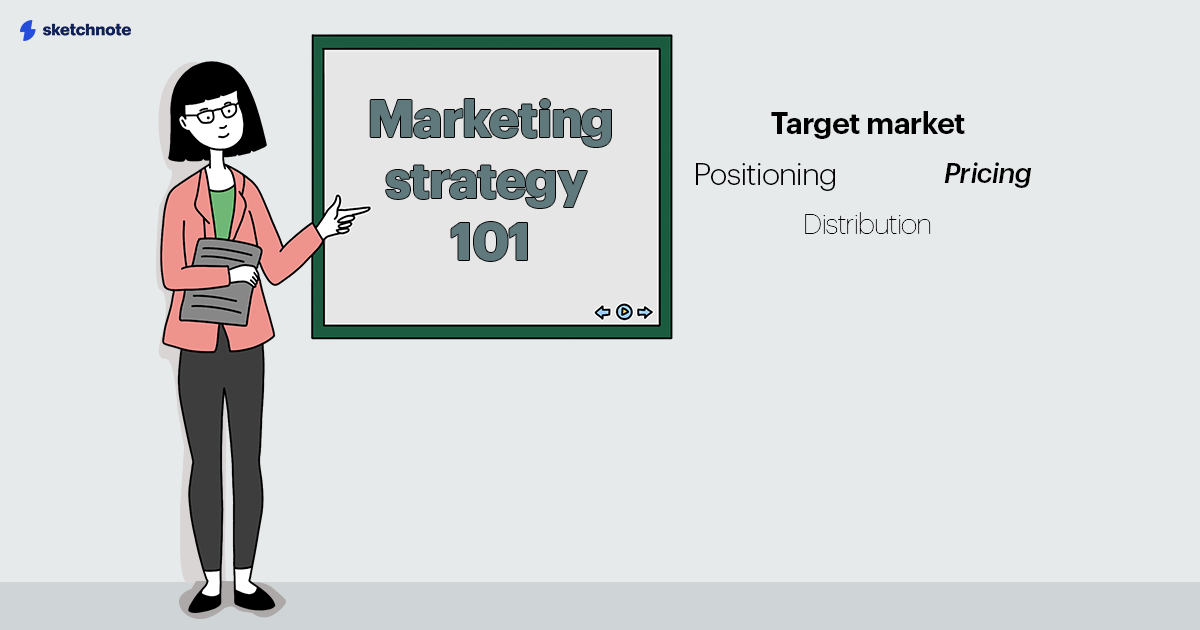Build it and they will come. Right?
Right?
Not quite.
Of course, a high-quality product is essential for generating positive word-of-mouth and building customer loyalty. However, even the best product won't sell itself. Therefore, effective marketing becomes extremely crucial for attracting customers and driving sales too!
The right balance of product and marketing can help a business thrive. In this context, a good marketing strategy will help you create and execute marketing campaigns.
What is a marketing strategy?
A marketing strategy is a forward-looking approach to marketing planning with the fundamental goal of achieving a sustainable competitive advantage for your company. It involves an analysis of the company's initial situation prior to the formulation, evaluation and selection of the most appropriate strategies to pursue.
A marketing strategy is typically divided into five distinct phases, namely researching the target market, working out the company's positioning, as well as determining the pricing, distribution, and product mix strategies. Let's dig deeper into these:
- Target market information in a marketing strategy should include demographic information such as age, gender, income, education level, and geographic location. It should also include psychographic information such as lifestyle, interests, values, and attitudes. Additionally, it should include information about the customer’s needs and wants, as well as the competitive landscape. Finally, it should include information about the customer’s buying habits, such as how often they purchase, what channels they use to purchase, and what motivates these customers.
- Positioning in marketing strategy is the process of creating an image or identity in the minds of consumers for a brand, product, or service. It involves differentiating the brand from its competitors and creating a unique and desirable position in the market. Positioning involves creating a unique value proposition that resonates with the target audience and differentiates the brand from its competitors. It also involves creating a brand identity that is consistent across all marketing channels and touchpoints.
- Pricing is the amount of money charged for a product or service and is a key factor in determining the success of a business. Pricing should be based on the value of the product or service, the cost of creating or producing it, and the competitive landscape. It should also take into account the customer’s willingness to pay and the company’s desired profit margin. Companies should also consider pricing strategies such as discounts and bundling.
- Distribution is the process of making a product or service available for use or consumption by a consumer or business user. This can include a variety of channels, such as email, social media, websites, and apps. The goal of distribution is to ensure that the marketing message reaches as many potential customers as possible, in a way that is effective and engaging. Distribution can be managed by the business itself, or it can be outsourced to an agency that specializes in digital marketing. The key is to find the right distribution channels and strategies to effectively reach the target audience.

The marketing mix
Once the above questions are answered, the next phase is determining the marketing mix. The marketing mix is a term used to describe the combination of tactics used by a business to achieve its marketing objectives. In the context of digital marketing, the marketing mix typically includes elements such as:
- Product: This refers to the goods or services that a business offers to its customers. A product might be a physical product that is sold online or offline, a digital product such as a piece of software, or a service such as website design.
- Price: This refers to the amount that a customer must pay to acquire a product or service. Pricing strategies might include offering special discounts or promotions, or using pricing tactics such as dynamic pricing or subscription-based pricing.
- Promotion: This refers to the various ways that a business can communicate with its customers and promote its products or services. Promotion activities might include tactics such as email marketing, social media marketing, search engine optimization (SEO), or content marketing.
- Place: This refers to the channels through which a business makes its products or services available to customers. In the context of digital marketing, place might include an online store or marketplace, a company website, or mobile app.
Together, these four elements make up the marketing mix in the context of digital marketing, and they are often referred to as the "4Ps" of marketing. By carefully considering each element and how they fit together, businesses can create effective marketing strategies that help them reach their target customers and achieve their marketing objectives.
Marketing plan
So what's the difference between a marketing strategy and a marketing plan? A marketing strategy is a high-level overview of the overall plan for reaching customers and achieving objectives. It outlines the general approach and the steps necessary to achieve the desired goals.
A marketing plan, on the other hand, is a detailed document that outlines the specific tactics and activities that will be used to execute the marketing strategy. It includes detailed information about the target market, the channels to reach the target audience, the budget, the timeline, and the resources needed to carry out the plan.
A marketing plan can help a business stay organized and focused on its marketing goals and can be used to communicate those goals to the rest of the company or to external stakeholders.
Market segmentation
Once you have your marketing strategy and associated plan, it's time to start executing your strategies. Where else does one start than segmenting your market? Indeed, knowing your target market is the alpha and omega of marketing.
In this context, market segmentation serves the purpose of allowing marketers to target specific groups of consumers with tailored messages and products. By carrying out segmentation, marketers can identify and target the most profitable segments, create more effective marketing campaigns, and develop products and services that meet the needs of specific customer groups.
This helps marketers to maximize their return on investment by focusing their efforts on the most profitable segments. Additionally, segmentation allows marketers to better understand their customers and develop more effective strategies for engaging them.
Positioning
In the context of digital marketing, positioning is the process of creating a unique online presence for a brand, product, or service that differentiates it from its competitors and makes it attractive to its target audience. This can be accomplished through a variety of digital marketing tactics, such as search engine optimization (SEO), content marketing, social media marketing, and email marketing. Since these channels are also used for promotion campaigns, it's useful to look at different communication channels in the context of both positioning and distribution.

Content marketing
Content marketing is a type of marketing that focuses on creating, publishing, and distributing content for a targeted audience online. It is often used to attract, engage, and retain customers. Content marketing can include blog posts, videos, podcasts, infographics, ebooks, webinars, and more. Content marketing is an effective way to build relationships with customers, increase brand awareness, and drive sales. It can also be used to educate customers about a product or service and to build trust.
- SEO Marketing is a type of content marketing arm that focuses on optimizing content for search engine algorithms. This type of content marketing involves creating content that is optimized for keywords and phrases that are relevant to the target audience. This content is then used to increase visibility in search engine results pages (SERPs) and drive more organic traffic to the website.
- Blogging is a form of content marketing that involves creating and publishing content on a blog. This content can be in the form of articles, videos, infographics, or other types of content. Blogging is a great way to build relationships with customers, increase brand awareness, and drive traffic to your website. It also helps to establish your business as an authority in your industry and can be used to educate customers about your products and services.
- Social media marketing is a form of content marketing that involves creating and sharing content on social media networks in order to achieve your marketing and branding goals. This content can include blog posts, videos, infographics, images, and other forms of content that are designed to engage your target audience and encourage them to take action. Social media marketing can be used to build brand awareness, generate leads, and drive sales. It can also be used to build relationships with customers and create a community around your brand.
- Influencer marketing is a type of content marketing that involves leveraging the influence of well-known individuals to promote a brand or product. This type of content marketing typically involves influencers creating content that is related to the brand or product, such as blog posts, videos, or social media posts. This content is then shared with their followers, who may be interested in the brand or product. This type of content marketing can be effective in helping to build brand awareness and trust, as well as driving sales
Guerrilla marketing
Beyond traditional digital marketing, smart teams will think of alternative tactics. Enter guerrilla marketing, which is a type of unconventional marketing strategy that uses surprise and/or unconventional tactics to promote a product or service. It is often used to target a specific audience and create a buzz around a product or service.
Common tactics used in guerrilla marketing include street art, flash mobs, viral videos, and interactive experiences. The goal of guerrilla marketing is to create a memorable experience that will be shared and talked about, thus creating a larger reach for the product or service
Niche marketing
Another clever way to execute marketing strategies centred around target audiences is niche marketing. Niche marketing focuses on a very specific demographic. It involves creating a product or service that appeals to a specific group of people, rather than a broad audience.
Niche marketing can be used to target a wide range of markets, including those based on age, gender, location, interests, and more. It is an effective way to reach a specific audience and can be used to create a loyal customer base. As military strategists say, having an angle of attack is often the most effective way to achieve victory in the field of battle.



